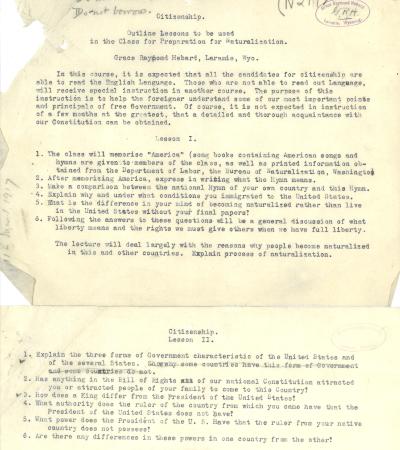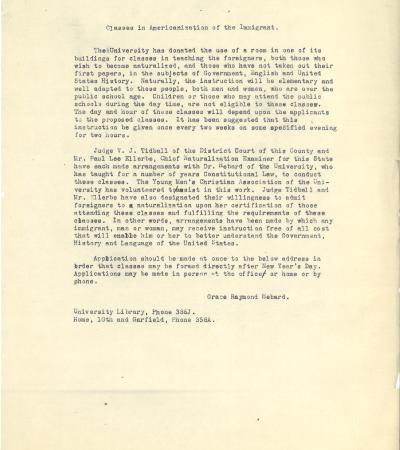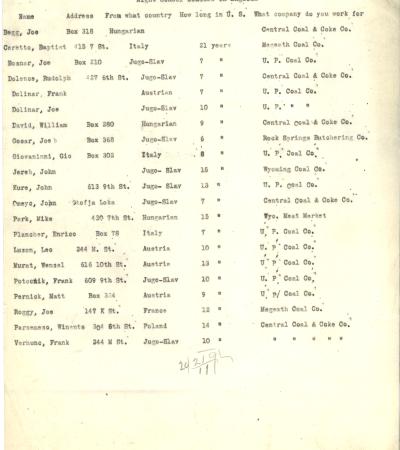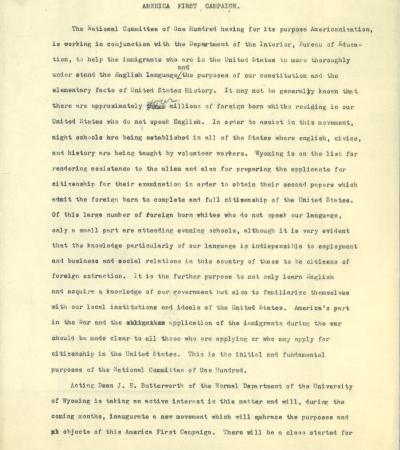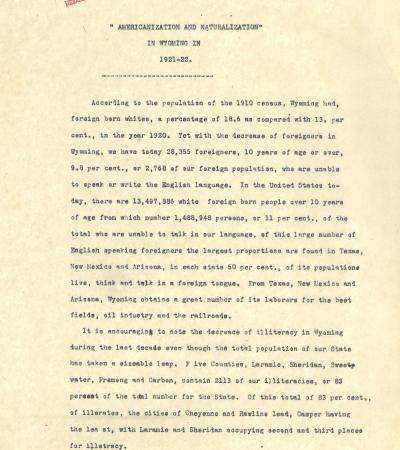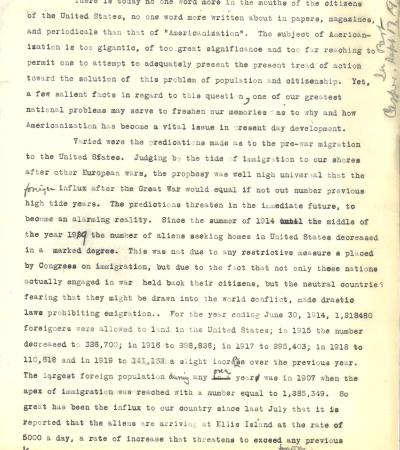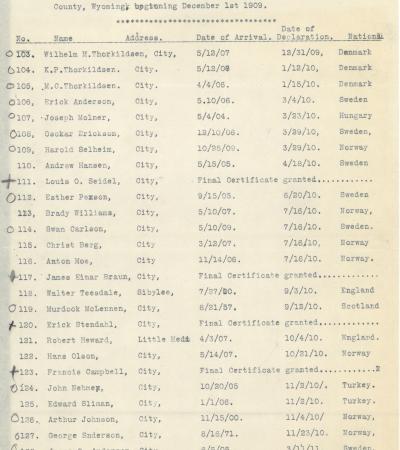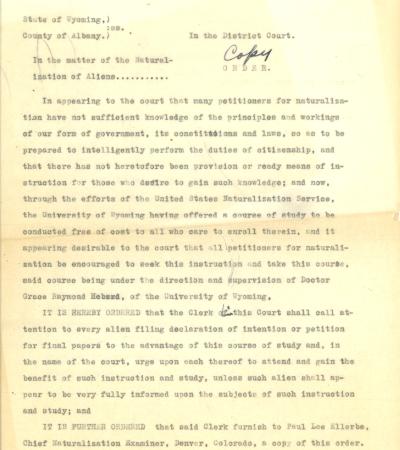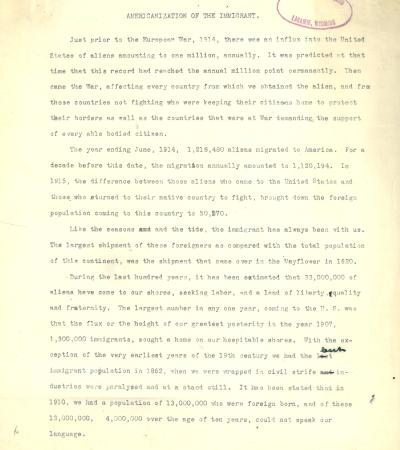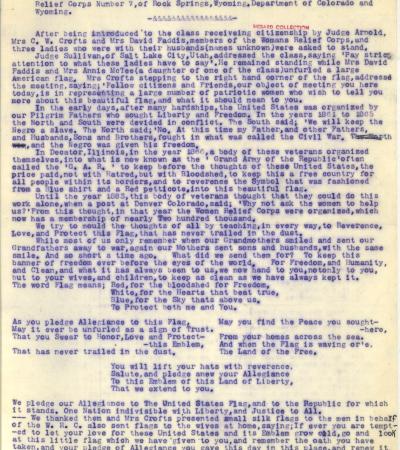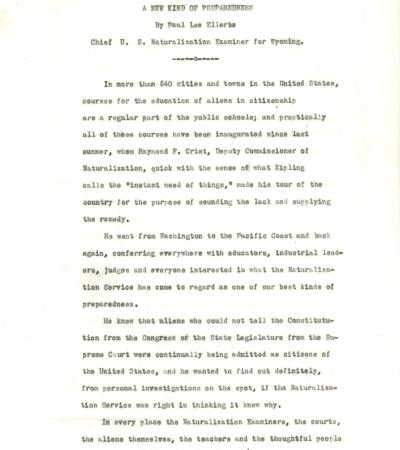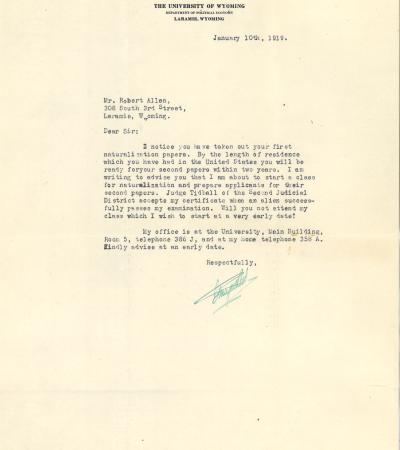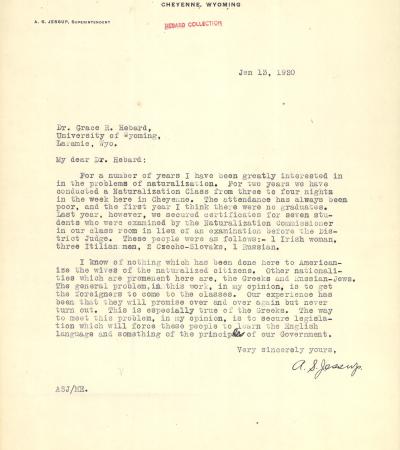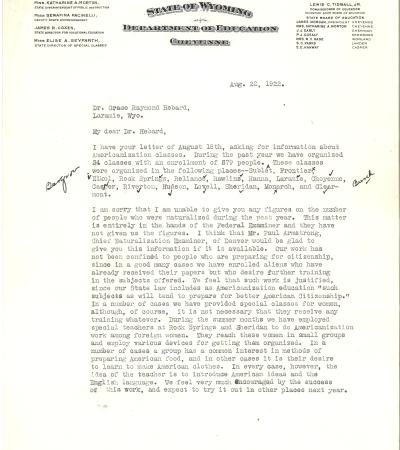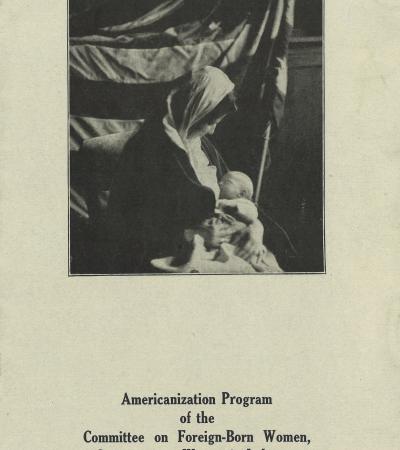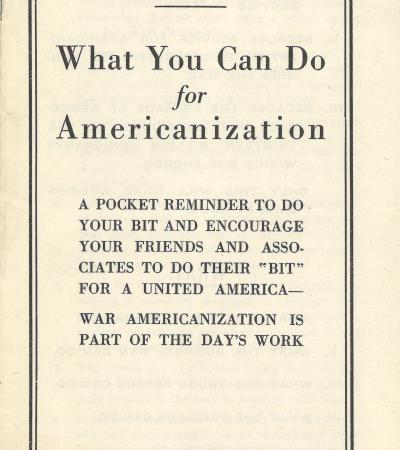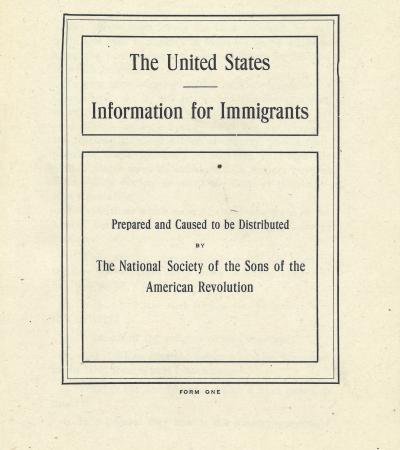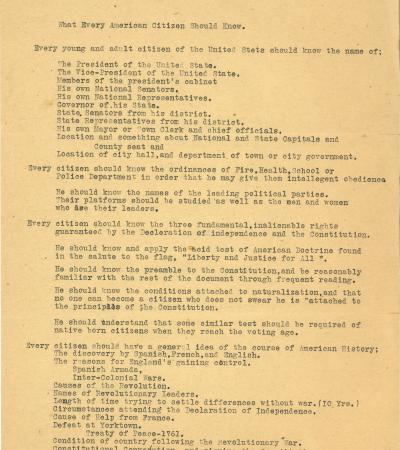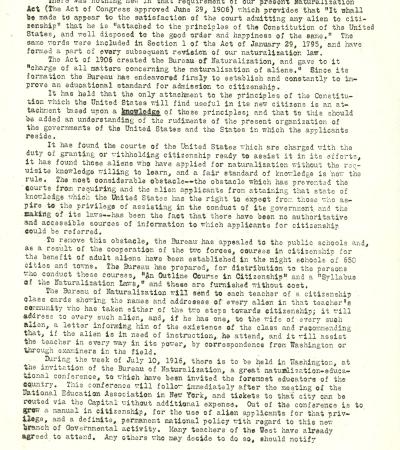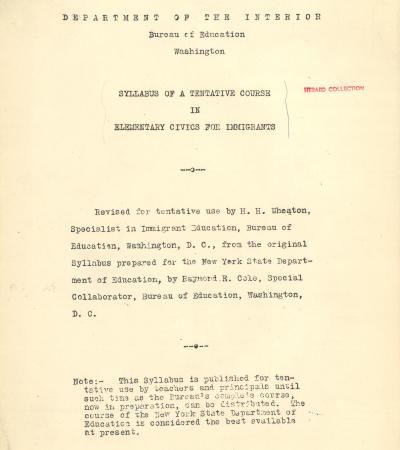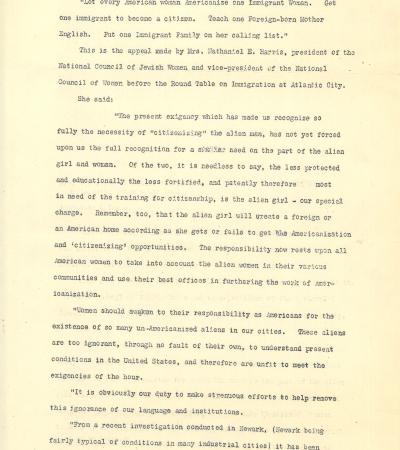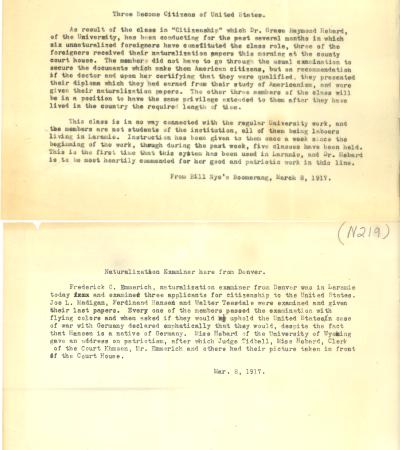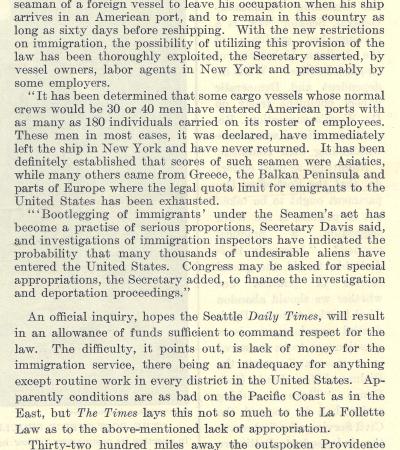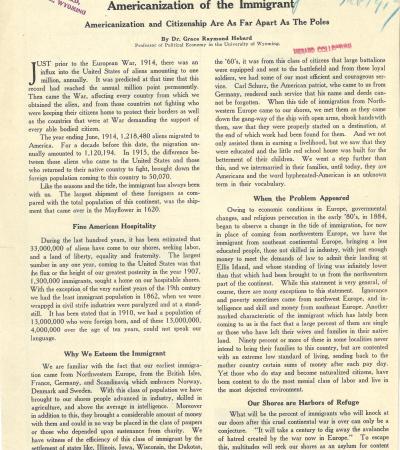Grace Raymond Hebard (1861-1936) was a professor and librarian at the University of Wyoming. In addition to her success in academia, she was the first woman to practice law in the state of Wyoming and eventually appointed the first vice president of the National Society of Women Lawyers. Hebard was active in civic and public affairs, including helping immigrants become American citizens. Her papers include information related to American citizenship classes she taught as well as papers and articles related to immigration.
Outline Lessons for Citizenship Class, 1917
This course outline, prepared by Professor Grace Raymond Hebard, was used for the evening citizenship classes she taught for immigrants in Laramie, Wyoming. It gives insight into the topics covered in the class.
"Classes in Americanization of the Immigrant"
This memo from Professor Grace Raymond Hebard announces that classes for the Americanization of immigrants will begin in Laramie.
"Enrollment Blank - Night School Classes in English"
This list of attendees of night school classes in English records the county of origin of each immigrant. Also noted is the employer of each immigrant.
"America First Campaign"
This paper describes a campaign called “America First,” which aimed to help immigrants in the U.S. learn English, understand American history, and prepare for citizenship. The campaign encouraged unity, loyalty to the country, and appreciation of American values and responsibilities.
"Americanization and Naturalization in Wyoming in 1921-22"
This paper discusses efforts in Wyoming in the early 1920s to help immigrants learn English, understand American history, and become U.S. citizens. Classes were held in cities and rural areas, with strong support from schools, community groups, and volunteers.
"America for Americans"
This paper argues that too many immigrants were entering the U.S. in the early 1900s, especially from Eastern Europe and Asia, and that this posed a threat to American jobs, culture, and unity. It supports strict Americanization—teaching immigrants English and U.S. history—and suggests immigrants who don’t adapt should be sent back to their home countries. The paper also expresses strong opposition to Japanese immigration, especially in California.
"List of Declaration of Intention to Become Citizens", 1909
This list, prepared by the Albany County, Wyoming District Clerk, provides insight into the nationality of immigrants seeking to become U.S. citizens in Albany County between 1909 and 1916.
Order of the Albany County District Court Regarding the Naturalization of Aliens, 20 November 1916
This court order encourages immigrants applying for U.S. citizenship to take free classes covering American government, laws, and citizenship taught by Professor Grace Raymond Hebard. The court believes these classes will help immigrants better understand their new country and become more informed citizens.
"Americanization of the Immigrant"
This paper discusses immigration to the U.S., noting a shift from skilled and educated immigrants from Northwestern Europe to less educated and poorer immigrants from Southeastern Europe. It argues that many immigrants lacked knowledge about American government and citizenship, and that more effort was needed to teach them English, history, and civic responsibility.
Description of a Green River, Wyoming Citizenship Ceremony, March 5, 1921
This description provides insight into a U.S. citizenship ceremony, touching on American history and the symbolism of the American flag.
"A New Kind of Preparedness" by Paul Lee Ellerbe
This paper, written by a U.S. naturalization examiner, talks about the need for better education to help immigrants understand American citizenship, government, and laws. It explains that many immigrants want to learn, but often don’t have access to schools or information about how to become fully prepared citizens. The author encourages communities, schools, and officials to create classes and support systems to help immigrants become informed and responsible Americans.
Letter from Professor Grace Raymond Hebard to Robert Allen, January 10, 1919
In this letter, Hebard attempts to recruit Allen as a student for her naturalization class. It is typical of the letters she sent to Albany county immigrants seeking to naturalize as U.S. citizens.
Letter from J.J. Early to Professor Grace Raymond Hebard, January 12, 1920
Early, the Superintendent of Sheridan Public Schools, replies to Hebard explaining what actions his school district has taken regarding citizenship classes for immigrants.
Letter from A.S. Jessup to Professor Grace Raymond Hebard, January 13, 1920
Jessup, the Superintendent of Cheyenne Public Schools, replies to Hebard. He explains the limited success his school district has had in conducting naturalization classes for immigrants.
Letter from the Superintendent of Kemmerer Schools to Professor Grace Raymond Hebard, January 13, 1920
The Superintendent of Kemmerer Public Schools replies to Hebard. He explains his district's action in running Americanization classes for immigrants. Notably, he cites statistics regarding foreign born residents in Lincoln County.
Letter from James R. Coxen to Professor Grace Raymond Hebard, August 22, 1922
Coxen, the Wyoming State Director for Vocational Education, replies to Hebard. He provides statewide statistics for the Americanization classes held, and describes efforts to reach female immigrants.
Letter from V.J. Tidball to Professor Grace Raymond Hebard, December 5, 1927
Tidball, a Wyoming state judge, writes in reply to Hebard. He notes that immigrants seeking citizenship can be denied naturalization papers if they have violated the prohibition law or if they claimed exemption from the draft during World War I.
Americanization Program Pamphlet
This World War I era pamphlet describes the Americanization Program which was created to help immigrants, especially women, become part of American life by learning English and understanding U.S. culture. It stresses that immigrants are vital to the country’s industries and communities, and that respect for their heritage should be balanced with learning American values.
"What You Can Do for Americanization" Pamphlet
This World War I era pamphlet, prepared by the National Americanization Committee, includes lists of actions every American can take to help with the Americanization of their immigrant neighbors.
"Information for Immigrants" Pamphlet
This pamphlet, prepared by the Sons of the American Revolution, was created to help immigrants understand what life in the U.S. is like and what opportunities are available to them. It explains that people in America are expected to work hard, follow the law, and can practice any religion freely. It also briefly describes how the government works, how immigrants can become citizens, and highlights the freedoms and possibilities available in the U.S.
"Naturalization of Aliens" Pamphlet
This pamphlet, prepared by the Sons of the American Revolution, describes how an immigrant can become a U.S. citizen, and briefly outlines the rights and duties of American citizens.
"What Every American Citizen Should Know", 1921
This document summarizes what American citizens were expected to know in 1921. Grace Raymond Hebard would have used this information to help formulate her lesson plans as she taught citizenship classes for immigrants in Albany county.
"Education for Citizenship"
This document, prepared by the chief naturalization examiner of Denver, explains that in order to become a U.S. citizen, immigrants must understand and support the principles of the Constitution and the government. The Bureau of Naturalization works with schools to offer free classes and materials to help immigrants learn about citizenship. It also encourages teachers to help immigrants join these classes.
Syllabus of a Tentative Course in Elementary Civics for Immigrants
This syllabus, prepared by the U.S. Bureau of Education, includes a wide variety of topics that would be covered in civics classes for immigrants like those taught by Grace Raymond Hebard.
Woman's War Work Press Release, March 2, 1918
This press release encourages American women to help immigrant women become citizens by teaching them English and introducing them to American culture and values. It highlights the challenges immigrant women face, such as high illiteracy rates and isolation from American life, and stresses the need for education programs in factories, schools, and homes. The goal is to help immigrant women build better lives and raise Americanized families.
Extracts from the Laramie Boomerang, March 1917
These extracts from the Laramie newspaper report on the naturalization of three immigrants following their completion of citizenship classes taught by Professor Grace Raymond Hebard.
"Bootleg Styles in Immigration", Literary Digest
This article warns that thousands of "undesirable" immigrants are sneaking into the U.S. by pretending to be sailors, using a loophole in the La Follette Seamen's Act. It claims that many jump ship at ports and disappear into the country, overwhelming immigration enforcement. Critics argue that this loophole is being abused and say immigration laws should be more strictly enforced to prevent illegal entry.
"Americanization of the Immigrant" by Professor Grace Raymond Hebard, February 1917
This article discusses the history of immigration to the U.S. and argues that true Americanization is more than just gaining citizenship—it requires understanding American values, language, and government. She contrasts earlier immigrants from Northwestern Europe, who were generally well-educated and quickly integrated, with later immigrants from Southeastern Europe, who often lacked education and lived in poverty. Hebard calls for stronger efforts in education and community involvement to help immigrants become informed citizens who are truly part of American democracy.
"Americanization Service of the Suffragists", National Suffrage News
This article describes how the National American Woman Suffrage Association helped immigrants become better U.S. citizens by teaching them about American history, government, and values. One suffragette, Dr. Grace Raymond Hebard, led citizenship classes in Laramie, Wyoming, having students take exams to prove their knowledge. The program aimed to prepare immigrants not just to pass a test, but to understand and fully embrace American citizenship and democracy.
